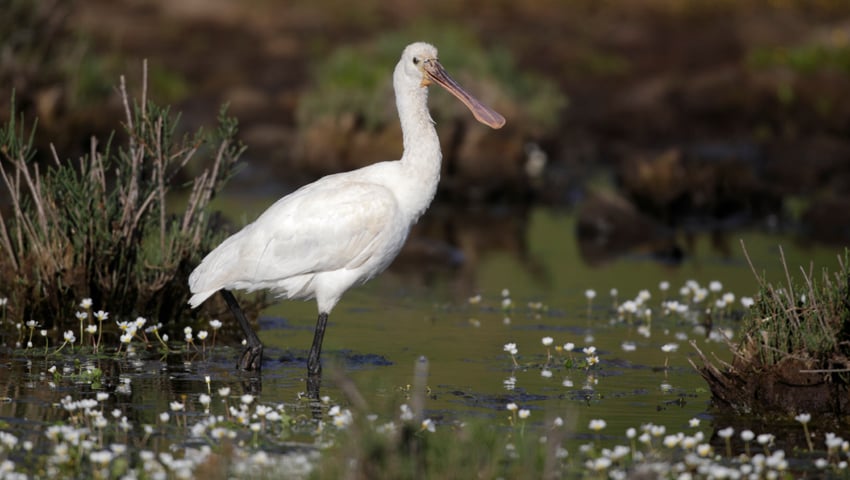Spoonbills are on track for another successful year, with birds breeding at multiple RSPB nature reserves across the UK, demonstrating how habitat management plays a vital role in nature conservation. The iconic wetland species, considered a rare breeding bird, used to be a common sight in the UK but was driven to extinction due to the draining of the East Anglian Fens and hunting.
There have been continued breeding successes this year for the wetland species at a number of RSPB nature reserves, including Havergate Island in Suffolk and Fairburn Ings in Yorkshire. And for the first time since the 17th century, spoonbills have nested in Cambridgeshire at RSPB Ouse Washes, the largest area of washland in the UK and a rich habitat for water birds.
Spoonbills are tall, white-feathered birds and named after their unique long bill that flattens at the end to create a spoon-like shape. These heron-sized birds have long black legs to wade through the waters they feed in. During the breeding season, adults develop a yellow tip on their bills and some yellow feathers on their breast, along with a white head crest.
Before their return, the last nesting spoonbill was recorded in 1668 and it wasn’t until 2010 that the first regular colony of breeding spoonbills established at Holkham Nature Reserve in Norfolk – now the UK’s largest colony.
Jonathan Taylor, Senior Site Manager at RSPB Ouse Washes, said, “The Ouse Washes are the perfect habitat for spoonbills and we are delighted to have these birds breeding for first time. Although they are breeding later here compared with other spoonbills in the UK, as is often the case with new colonies, it is fantastic that this iconic and highly adapted heron species has returned and is using our wetlands once again”.
Spoonbills can typically be spotted along coastal sites in southern and eastern England, where they feed on small fish, shrimps and aquatic invertebrates which they catch while sweeping their highly adapted spoon-shaped bill from side to side in shallow water.
Spoonbills have also now been breeding at RSPB Fairburn Ings, near Leeds, for the eighth consecutive year and numbers have increased to around 8-10 nests. The species is spreading northwards in Europe in response to climate change and their success at RSPB Fairburn Ings is thanks to dedicated conservation efforts to provide and restore vital shallow wetland habitat on which these striking birds depend.
A pair of spoonbills first bred at RSPB Fairburn Ings in 2017 and experts have been monitoring ten nests this year. The reserve team continue to watch the birds avidly, with nine chicks already fledged and others being fed by their parents on the nest. Whilst the final breeding season results won’t be ready until the end of August, the excitement continues to build for this very special species.
Karen Swaffield, Warden at RSPB Fairburn Ings in Yorkshire, said, “It’s tremendously exciting to have spoonbills here and early indications are that they have had yet another successful breeding year. We nicknamed baby spoonbills “teaspoons” in 2017 and the name has stuck. We’re thrilled that the spoonbills have been here for eight years in a row, and we really hope this means they are here to stay. If the last pair which are currently nest-building manage to fledge a chick, we will have had a record year, so we are all on tenterhooks to see what happens next”.
At RSPB Havergate Island in Suffolk, the reserve team worked since the mid-2000s to get spoonbills nesting, and breeding started in 2019. The site now is now home to the only ground-nesting colony in the UK with an impressive 17 breeding pairs, making this the second largest population in the country.
Aaron Howe, South Suffolk Sites Manager for the RSPB, explains that this has been achieved through a combination of measures: “We have undertaken lots of work over the years to create a haven for spoonbills, such as making the nesting island secure with fencing and ensuring there is ample suitable feeding in the estuary. It’s fantastic to see them nest here and we’re expecting another successful year with more than 30 chicks ready to fledge”.
Monitoring the birds during the breeding season helps experts understand the ecology and behaviour of spoonbills. By recording the number of pairs, nests, timing of nesting attempts, feeding behaviour and breeding productivity (how many young fledge), reserve teams get a clearer picture of how this species is doing and what conservation work can be done to improve the habitat for them.
Despite their turbulent history in the UK, it is very special to have spoonbills successfully nesting in more locations than ever. The estuaries, saltmarshes and coastal lagoons across the UK provide vitally important feeding grounds for spoonbills and the spread of breeding colonies at different RSPB nature reserves, demonstrates the importance of having a network of feeding and breeding habitats available for these birds to thrive.
